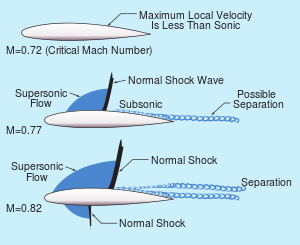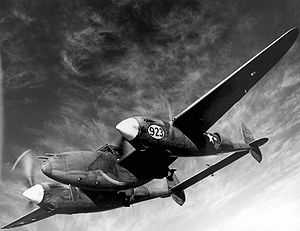Mach tuck
Mach tuck is an aerodynamic effect whereby the nose of an aircraft tends to downward pitch as the airflow around the wing reaches supersonic speeds; the aircraft will first experience this effect at significantly below Mach 1.[1] This speed is known as the critical Mach number of the wing.

Causes
Mach tuck is caused by a rearward movement of the centre of pressure in transonic flight. As an aerofoil passes through the air, the air flowing over the top surface accelerates to a higher local speed as part of the mechanism for generating lift. When the aircraft speed reaches its critical Mach number the accelerated airflow locally reaches the speed of sound and creates a small shock wave, even though the aircraft as a whole is still travelling below the speed of sound. The region in front of the shock wave generates high lift. As the aircraft itself flies faster, the shock wave over the wing gets bigger and moves rearwards, creating high lift further back along the wing. This rearward movement of lift causes the aircraft tail to rise and the nose to pitch down or "tuck."
The severity of Mach tuck on any given design is affected by the choice of aerofoil, the sweep angle of the wing, and any resulting change in airflow over the tailplane.
The camber and thinness of the aerofoil affect the critical Mach number, with a more highly curved upper surface having a lower value.
On a swept wing the shock wave typically forms first at the wing root, especially if it is more cambered than the wing tip. As speed increases, the shock wave and associated lift extend outwards and, because the wing is swept, backwards.
The changing airflow over the wing can affect the downwash over a conventional tailplane, further aggravating the effect and making it difficult to recover.
Another problem with a separate horizontal stabiliser is that it can itself achieve local supersonic flow with its own shock wave. This can affect the operation of a conventional elevator control surface.
Aircraft without enough elevator authority to maintain trim and stay level can enter a steep, sometimes unrecoverable dive.[2] Until the aircraft is supersonic, the faster top shock wave can reduce the authority of the elevator and horizontal stabilizers.[3]
All transonic and supersonic aircraft experience Mach tuck.
Recovery
Recovery is sometimes impossible in subsonic aircraft; however, as an aircraft descends into lower, warmer, denser air, control authority may return because drag tends to slow the aircraft while the speed of sound and control authority both increase.
To prevent Mach stall from progressing, the pilot should keep the airspeed below the type's critical Mach number by reducing throttle, extending speed brakes, and if possible, extending the landing gear.
Design features
A number of design techniques are used to counter the effects of Mach tuck.
On both conventional tailplane and canard foreplane configurations. the horizontal stabiliser may be made large and powerful enough to correct the large trim changes associated with Mach tuck. In place of the conventional elevator control surface, the whole stabiliser may be made moveable or "all-flying", sometimes called a stabilator. This both increases the authority of the stabilizer over a wider range of aircraft pitch, but also avoids the controllability issues associated with a separate elevator.[3]
Aircraft that fly supersonic for long periods, such as Concorde, may compensate for Mach tuck by moving fuel between tanks in the fuselage to change the position of the centre of mass to match the changing location of the centre of pressure, thereby minimize the amount of aerodynamic trim required.
A Mach trimmer is a device which varies the pitch trim automatically as a function of Mach number to oppose Mach tuck and maintain level flight.
History

The fastest World War II fighters were the first aircraft to experience Mach tuck. Their wings were not designed to counter mach tuck because research on supersonic airfoils was just beginning; the shock wave would engulf the entire wing. The P-38 was the first 400 mph fighter, and it suffered more than the usual teething troubles.[4] It had a thick, high-lift wing for quick climbing and holding much fuel. It also had three fuselages: the central weapon and pilot nacelle or gondola and the twin booms, which contained engines and turbochargers. It also was a very dense fighter for its day, and it quickly accelerated to terminal velocity in a dive. Bernoulli's effect very strongly worked on the thick wing and was even more pronounced where air was pushed away by and compressed between the nacelle and booms. Mach tuck would occur when the aircraft attained Mach 0.68; the air flow over the wing roots would become transonic, and the wing therefore would lose lift, thereby aftward moving the normal loading of the tail's horizontal control surfaces, leaving the elevator unloaded, bringing the nose further down in a Mach tuck. Lockheed engineers eventually added a small 'speed bump' flap beneath the wing; the pilot would engage it upon diving. The flap changed the pressure distribution so that Mach tuck ceased to be a problem.[4]
References
- ↑ Pilot’s Handbook of Aeronautical Knowledge. U.S. Government Printing Office, Washington D.C.: U.S. Federal Aviation Administration. 2003. pp. 3–37 to 3–38. FAA-8083-25.
- ↑ Airplane Flying Handbook. U.S. Government Printing Office, Washington D.C.: U.S. Federal Aviation Administration. 2004. pp. 15–7 to 15–8. FAA-8083-3A.
- ↑ 3.0 3.1 Transonic Aircraft Design
- ↑ 4.0 4.1 Bodie, Warren M. The Lockheed P-38 Lightning: The Definitive Story of Lockheed's P-38 Fighter. Hayesville, North Carolina: Widewing Publications, 2001, 1991. ISBN 0-9629359-5-6.
![]() This article incorporates public domain material from the United States Government document "Airplane Flying Handbook".
This article incorporates public domain material from the United States Government document "Airplane Flying Handbook".
![]() This article incorporates public domain material from the United States Government document "Pilot's Handbook of Aeronautical Knowledge".
This article incorporates public domain material from the United States Government document "Pilot's Handbook of Aeronautical Knowledge".